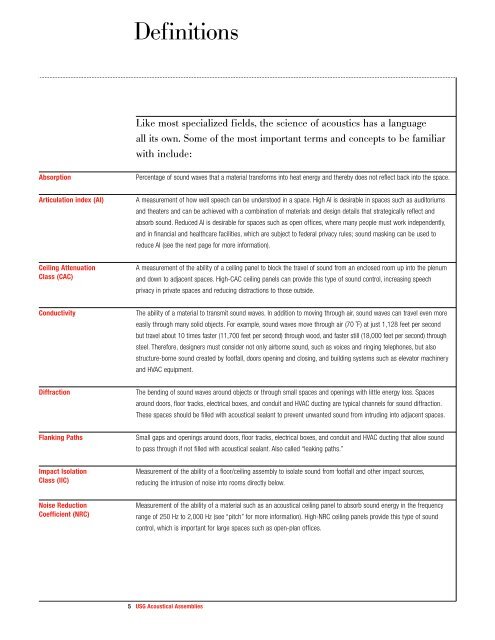acoustical-assemblies-en-SA200
acoustical-assemblies-en-SA200
acoustical-assemblies-en-SA200
You also want an ePaper? Increase the reach of your titles
YUMPU automatically turns print PDFs into web optimized ePapers that Google loves.
DefinitionsLike most specialized fields, the sci<strong>en</strong>ce of acoustics has a languageall its own. Some of the most important terms and concepts to be familiarwith include:AbsorptionPerc<strong>en</strong>tage of sound waves that a material transforms into heat <strong>en</strong>ergy and thereby does not reflect back into the space.Articulation index (AI)A measurem<strong>en</strong>t of how well speech can be understood in a space. High AI is desirable in spaces such as auditoriumsand theaters and can be achieved with a combination of materials and design details that strategically reflect andabsorb sound. Reduced AI is desirable for spaces such as op<strong>en</strong> offices, where many people must work indep<strong>en</strong>d<strong>en</strong>tly,and in financial and healthcare facilities, which are subject to federal privacy rules; sound masking can be used toreduce AI (see the next page for more information).Ceiling Att<strong>en</strong>uationClass (CAC)A measurem<strong>en</strong>t of the ability of a ceiling panel to block the travel of sound from an <strong>en</strong>closed room up into the pl<strong>en</strong>umand down to adjac<strong>en</strong>t spaces. High-CAC ceiling panels can provide this type of sound control, increasing speechprivacy in private spaces and reducing distractions to those outside.ConductivityThe ability of a material to transmit sound waves. In addition to moving through air, sound waves can travel ev<strong>en</strong> moreeasily through many solid objects. For example, sound waves move through air (70 ˚F) at just 1,128 feet per secondbut travel about 10 times faster (11,700 feet per second) through wood, and faster still (18,000 feet per second) throughsteel. Therefore, designers must consider not only airborne sound, such as voices and ringing telephones, but alsostructure-borne sound created by footfall, doors op<strong>en</strong>ing and closing, and building systems such as elevator machineryand HVAC equipm<strong>en</strong>t.DiffractionThe b<strong>en</strong>ding of sound waves around objects or through small spaces and op<strong>en</strong>ings with little <strong>en</strong>ergy loss. Spacesaround doors, floor tracks, electrical boxes, and conduit and HVAC ducting are typical channels for sound diffraction.These spaces should be filled with <strong>acoustical</strong> sealant to prev<strong>en</strong>t unwanted sound from intruding into adjac<strong>en</strong>t spaces.Flanking PathsSmall gaps and op<strong>en</strong>ings around doors, floor tracks, electrical boxes, and conduit and HVAC ducting that allow soundto pass through if not filled with <strong>acoustical</strong> sealant. Also called “leaking paths.”Impact IsolationClass (IIC)Measurem<strong>en</strong>t of the ability of a floor/ceiling assembly to isolate sound from footfall and other impact sources,reducing the intrusion of noise into rooms directly below.Noise ReductionCoeffici<strong>en</strong>t (NRC)Measurem<strong>en</strong>t of the ability of a material such as an <strong>acoustical</strong> ceiling panel to absorb sound <strong>en</strong>ergy in the frequ<strong>en</strong>cyrange of 250 Hz to 2,000 Hz (see “pitch” for more information). High-NRC ceiling panels provide this type of soundcontrol, which is important for large spaces such as op<strong>en</strong>-plan offices.5 USG Acoustical Assemblies


